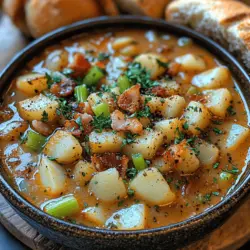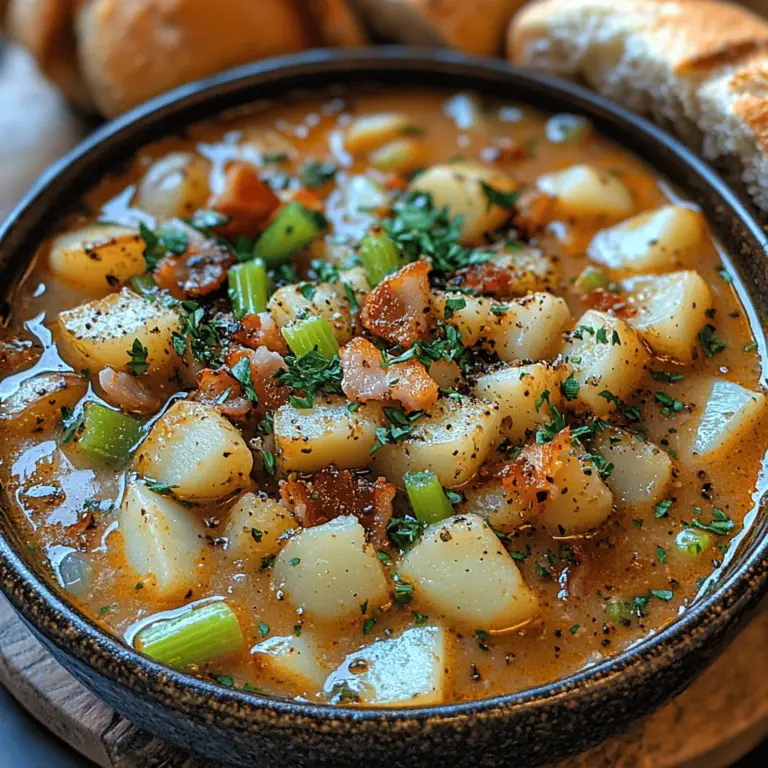Introduction
New England Clam Chowder is much more than just a dish; it’s a culinary emblem steeped in the rich traditions of New England culture. This creamy, hearty soup has long been cherished by locals and visitors alike, evoking feelings of warmth and nostalgia with every spoonful. Often associated with cold coastal evenings, clam chowder serves as a comforting reminder of the region’s maritime heritage. With its delectable blend of flavors and textures, this dish encapsulates the essence of New England’s rugged yet inviting character.
Comfort food holds a special significance in culinary traditions, particularly in New England, where the long winters and coastal lifestyle have shaped a cuisine centered around hearty, satisfying meals. Clam chowder epitomizes this idea, offering not only warmth but also a deep connection to the sea and the community that thrives around it. In this article, we will take you through the journey of creating a classic New England Clam Chowder, highlighting its key elements and the care that goes into crafting this beloved dish.
The Heart of New England Clam Chowder
At its core, traditional clam chowder is a simple yet elegant dish that fuses fresh ingredients to create a rich, comforting experience. This soup typically features a creamy base enriched with the briny flavor of clams, alongside vegetables and seasonings that enhance its complexity. The historical roots of clam chowder can be traced back to the early settlers of New England, who relied on local resources to create hearty meals. The word “chowder” is believed to have originated from the French term “chaudière,” referring to the pot used to cook this delightful dish.
While the classic version of clam chowder is known for its creamy texture, various regional variations exist, each with its own unique twist. For instance, Manhattan Clam Chowder offers a tomato-based alternative that differs significantly from its creamy counterpart. However, the New England version remains the most celebrated, known for its rich, velvety consistency and the balance of savory flavors.
In our recipe, we will use a selection of ingredients that are quintessential to creating an authentic clam chowder. Each component plays a crucial role in building layers of flavor and texture. The combination of thick-cut bacon, fresh clams, aromatic vegetables, and a creamy base creates a dish that is not only delicious but also deeply satisfying.
Ingredient Breakdown
To make the perfect New England Clam Chowder, it’s essential to select the freshest ingredients available. Below is a detailed description of each ingredient and its significance in the overall dish:
Thick-Cut Bacon
The introduction of thick-cut bacon is a game changer for this chowder. Bacon not only adds a delightful crunch but also infuses the soup with a smoky flavor that elevates the overall taste. As the bacon renders, it releases its fat, which serves as a flavorful base for sautéing the vegetables. Opting for high-quality, smoked bacon will ensure a robust flavor that complements the brininess of the clams.
Onion and Celery
Aromatic vegetables like onion and celery form the foundation of our chowder. These ingredients provide essential flavor and depth to the soup. When sautéed in the bacon fat, they soften and release their natural sweetness, contributing to the overall complexity of the dish. It’s important to chop these vegetables finely to ensure even cooking and to prevent them from overpowering the delicate clam flavor.
Potatoes
Potatoes are the heart of any clam chowder, providing substance and a creamy texture. For this recipe, we recommend using Yukon Gold or Russet potatoes, as they break down slightly during cooking, thickening the chowder while still holding their shape. The starch from the potatoes not only adds heartiness but also contributes to the chowder’s signature creaminess.
Clams
The star of the show, clams, are what truly define this dish. Whether you choose fresh or canned clams, their briny essence is essential for an authentic chowder. Fresh clams, such as littlenecks or cherrystones, provide a sweet and salty flavor that is unparalleled. If using canned clams, it’s vital to select high-quality options packed in their juice to retain maximum flavor. When sourcing clams, always look for those that are sustainably harvested, supporting local fisheries and ensuring the best quality.
Dairy (Heavy Cream and Milk)
To achieve the rich, creamy texture that clam chowder is famous for, a combination of heavy cream and milk is used. Heavy cream contributes a luxurious thickness, while milk lightens the overall texture without compromising on richness. The balance between the two creates a chowder that is indulgently creamy yet satisfying without being overly heavy.
Seasonings (Thyme, Bay Leaves, Salt, and Pepper)
Seasonings are the unsung heroes of clam chowder, enhancing the natural flavors of the ingredients. Fresh thyme adds an herbal note that complements the brininess of the clams, while bay leaves provide a subtle depth. Salt and pepper are essential for balancing flavors, ensuring that each ingredient shines through. It’s important to season to taste, adjusting as necessary throughout the cooking process.
Importance of Freshness in Ingredients
The freshness of your ingredients will greatly influence the final outcome of your clam chowder. Using fresh vegetables, high-quality clams, and dairy products will yield a dish that is vibrant and flavorful. Whenever possible, source your ingredients from local markets or farms to ensure you are working with the best available produce.
Preparation Steps
Now that we have gathered all the necessary ingredients, it’s time to dive into the preparation of our New England Clam Chowder. Below is a step-by-step breakdown of the cooking process, beginning with one of the most crucial steps: rendering the bacon.
Step 1: Rendering the Bacon
Start by dicing the thick-cut bacon into small, bite-sized pieces. Place the bacon in a large, heavy-bottomed pot over medium heat. As the bacon cooks, it will begin to render its fat, which is essential for sautéing the vegetables and adding depth of flavor to the chowder.
To achieve perfectly crispy bacon, allow it to cook slowly, stirring occasionally to ensure even cooking. The goal is to render out the fat while achieving a golden brown color. This process typically takes about 8-10 minutes. Once the bacon is crispy and beautifully caramelized, use a slotted spoon to remove it from the pot, leaving the rendered fat behind. This fat will serve as the flavor base for the chowder, so don’t discard it!
Step 2: Sautéing the Aromatics
With the bacon fat still in the pot, add the finely chopped onion and celery. Sauté the vegetables over medium heat until they are softened and translucent, which should take around 5-7 minutes. As they cook, the aromatic scents will fill your kitchen, setting the stage for a comforting meal.
Step 3: Adding the Potatoes
Next, add the diced potatoes to the pot, stirring them in with the sautéed vegetables. This step is important as the potatoes will absorb the flavors from the aromatics and bacon fat, enriching the overall taste of the chowder. Pour in enough chicken or vegetable broth to cover the potatoes, usually about 4 cups. This liquid will provide the necessary depth and body to the chowder.
Let the mixture come to a gentle simmer, covering the pot to retain heat and encourage the potatoes to cook through. Cook for about 10-15 minutes, or until the potatoes are fork-tender. During this time, keep an eye on the pot, stirring occasionally to prevent sticking and ensure even cooking.
Step 4: Introducing the Clams
Once the potatoes have softened, it’s time to introduce the clams into the mix. If using fresh clams, make sure to clean them thoroughly by scrubbing their shells under cold water. Add the clams to the pot along with any reserved clam juice if using canned clams. Stir gently to combine, allowing the clams to heat through and release their briny flavor into the chowder.
Step 5: Incorporating the Dairy
After the clams have been added and heated through, lower the heat and stir in the heavy cream and milk. This is where the chowder takes on its signature creamy texture. Stir gently to combine, ensuring that the soup does not boil after adding the dairy, as this can cause it to curdle. Allow the chowder to warm through for an additional 5-10 minutes, during which time the flavors will meld together beautifully.
Step 6: Seasoning to Taste
As a final touch, add the fresh thyme, bay leaves, salt, and pepper to taste. Taste the chowder and adjust the seasoning as needed, keeping in mind that the flavors will continue to develop as the chowder sits. Remove the bay leaves before serving, as they are not meant to be eaten.
With these initial steps completed, you are well on your way to creating a delicious bowl of New England Clam Chowder that embodies the essence of comfort and warmth. The combination of flavors and textures will transport you to the shores of New England, allowing you to savor each spoonful as if you were sitting in a cozy seaside diner.
Stay tuned for the next part of this article, where we will explore additional cooking tips, variations, and suggestions for serving this delightful dish, ensuring that your clam chowder experience is nothing short of extraordinary.
{{image_1}}
Sautéing Vegetables
The foundation of any great chowder begins with the vegetables, and in our New England Comfort in a Bowl recipe, we start by sautéing a blend of onions, celery, and garlic. This initial step is crucial because cooking these aromatics in bacon fat infuses the dish with a rich, smoky flavor that sets the stage for the entire chowder. The rendered bacon fat not only enhances the taste but also adds a depth that is characteristic of traditional New England chowder.
To achieve the best results, heat a large Dutch oven over medium heat, allowing the bacon fat to melt completely. Once the fat is shimmering, add the diced onions. Sautéing the onions until they become translucent before adding the celery and garlic will ensure that each vegetable retains its individual flavor while melding beautifully together. This process should take about 5 to 7 minutes, allowing the vegetables to soften and release their natural sweetness.
Incorporating Potatoes and Seasonings
With the vegetables perfectly sautéed, it’s time to layer in the potatoes and seasonings. The addition of diced potatoes not only adds heartiness to the chowder but also contributes to the overall texture. For this recipe, Yukon Gold potatoes are ideal due to their creamy consistency. After adding the potatoes, sprinkle in the seasonings—salt, freshly cracked black pepper, and a hint of thyme. These spices elevate the flavor profile, ensuring that every spoonful is rich and satisfying.
Next, pour in the clam juice and enough water to cover the potatoes completely. Bring the mixture to a gentle simmer, allowing the potatoes to cook until they are fork-tender, which should take about 15 to 20 minutes. The key here is to maintain a low simmer, which helps in developing the flavors while ensuring the potatoes cook evenly without falling apart.
Adding Clams
Now, let’s talk about the star of the show: the clams. When it comes to adding clams to your chowder, the method can vary depending on whether you opt for fresh or canned clams. For fresh clams, such as littlenecks or cherrystones, you need to clean them thoroughly and steam them until they open before adding them to the chowder. This process not only enhances their flavor but also ensures they are tender and delightful.
If you’re using canned clams, which are a convenient option, they are typically pre-cooked and can be added directly to the chowder in the final stages of cooking. Once the potatoes are tender, stir in the clams along with their juice. Allow them to warm through, which should take about 5 minutes. Remember that the goal is to include the clams without overcooking them, as they can become rubbery.
Thickening the Chowder
To achieve that classic chowder consistency, it’s essential to thicken the mixture appropriately. This is where the roux comes into play. A roux is a mixture of equal parts flour and fat, which acts as a thickening agent. In this recipe, after the clams are added, create a roux in a separate pan by melting a couple of tablespoons of butter over medium heat and whisking in the flour until it forms a paste. Cook this mixture for about 2 minutes to eliminate the raw flour taste.
Once your roux is ready, gradually whisk it into the chowder. This step will help thicken your chowder without clumping, resulting in a smooth and creamy texture. After incorporating the roux, let the chowder simmer for an additional 10 minutes to allow the flavors to meld and the chowder to thicken perfectly.
Final Touches
Before serving, it’s important to balance the flavors and textures. To accomplish this, stir in heavy cream or half-and-half for that luxurious creaminess. This addition not only enhances the taste but also gives the chowder a beautiful, velvety finish. Taste the chowder and adjust the seasoning if necessary, adding more salt, pepper, or a dash of hot sauce for a little kick.
Additionally, consider adding fresh herbs like chopped parsley or dill at this stage for a burst of color and flavor. Once everything is well combined and heated through, your chowder is ready to be served, inviting the comfort of New England right into your kitchen.
Serving Suggestions
When it comes to serving your chowder, presentation matters. Ladle the thick, creamy chowder into warm bowls, allowing the inviting aroma to fill the air. To elevate the dining experience, serve alongside oyster crackers for a delightful crunch that complements the chowder’s richness. For those who enjoy a heartier meal, crusty bread or a fresh baguette makes for an excellent accompaniment, perfect for dipping.
To enhance the presentation, consider garnishing each bowl with a sprinkle of fresh parsley or chives, or even a drizzle of olive oil. A dusting of smoked paprika can also add a touch of color and an extra layer of flavor that complements the chowder beautifully.
Nutritional Information
Understanding the nutritional benefits of your ingredients can enrich your appreciation of this dish. Clams are a fantastic source of protein, low in fat, and provide essential vitamins and minerals, including vitamin B12, iron, and omega-3 fatty acids. The addition of potatoes contributes fiber and potassium, making this chowder not only comforting but also nourishing.
On average, a serving of this New England clam chowder contains approximately 350-400 calories, depending on the specific quantities of cream and bacon used. For those mindful of dietary considerations, there are easy adjustments you can make. Opt for low-fat dairy alternatives or reduce the amount of bacon to decrease the overall fat content without sacrificing flavor.
Cultural Context and Personal Touch
Clam chowder holds a special place in the hearts of many New Englanders, often evoking nostalgia and memories of family gatherings. This dish is more than just a meal; it reflects the region’s rich maritime heritage and culinary traditions. Historically, clam chowder was a staple for sailors and fishermen who relied on the ocean’s bounty, making it a dish of comfort and sustenance.
In my own family, clam chowder was a weekend tradition, simmering on the stove during chilly autumn afternoons. The smell of bacon and clams would waft through the house, drawing us together at the table. Each bite would remind us of our roots, celebrating not only the flavors of New England but also the warmth of family and home.
Conclusion
As you bring this New England Comfort in a Bowl to your table, remember the key elements that make this clam chowder a timeless classic. The rich flavors from sautéed vegetables, the heartiness of potatoes, and the delightful texture of clams come together in perfect harmony. This recipe encapsulates not only the essence of comfort food but also the rich tradition of clam chowder that has been cherished for generations.
Embracing this dish in your cooking will not only warm your home but also evoke a sense of joy and connection to those who have enjoyed it before you. So gather your loved ones, ladle out some chowder, and celebrate the rich culinary heritage of New England, one comforting bowl at a time.



